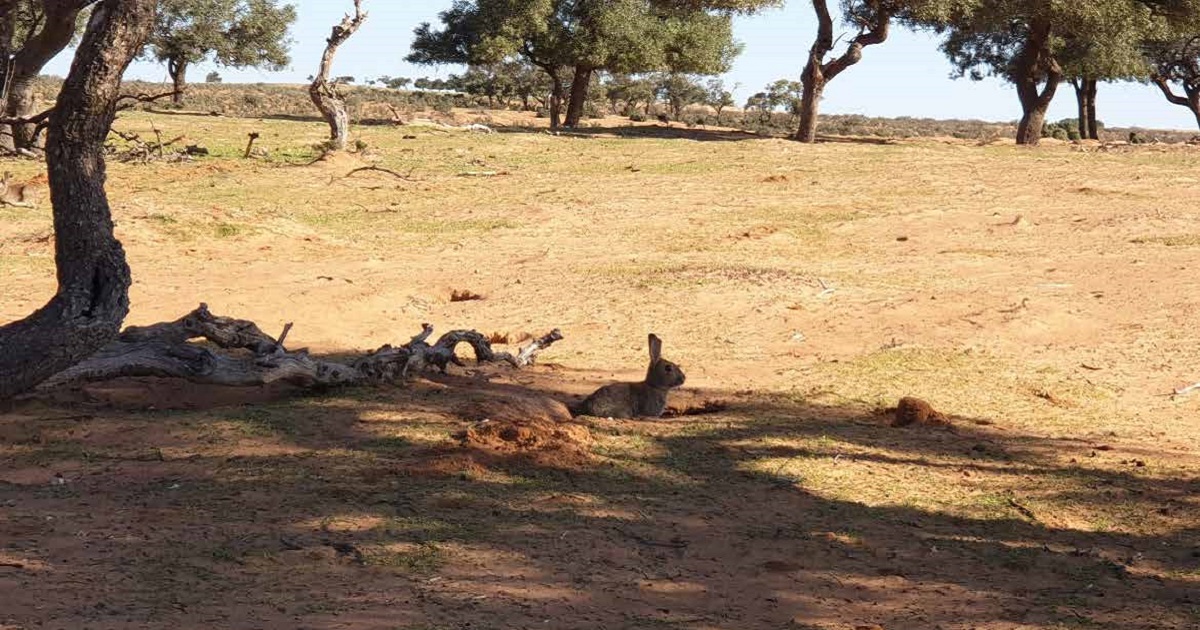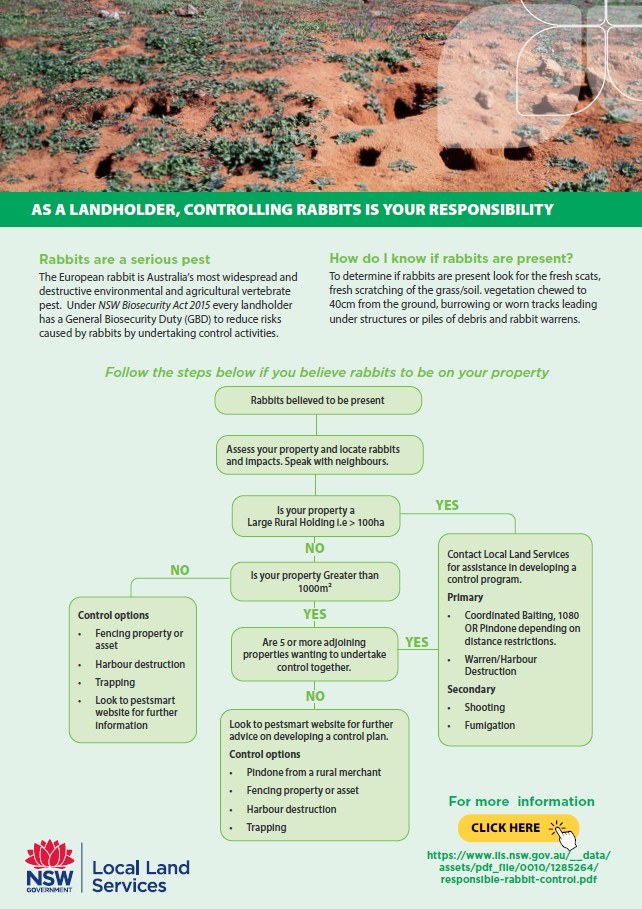Wild rabbits
The European rabbit is one of Australia’s most widespread and destructive environmental and agricultural vertebrate pests.
Impact of wild rabbits
Wild rabbits cause significant economic losses to agriculture by damaging crops and pastures, creating significant grazing pressures and disturbing soils leading to erosion and loss of topsoil.
Rabbits can have a major impact on grazing, native flora, horticultural industries and gardens. They are a key threatening process for flora species within the region.
Rabbits damage our local environments and pose a biosecurity risk by:
- destroying vegetation including lawns, playing fields, natural systems and agricultural lands
- directly competing with stock and native animals for food and habitat
- causing erosion, soil loss, destabilisation of waterway banks and undermining building foundations.
Control of wild rabbits
To meet your general biosecurity duty, all landholders must reduce risks caused by rabbit populations on land under their care and control by undertaking rabbit control activities.
Examples of rabbit control activities you could undertake to achieve your general biosecurity duty are:
- undertaking both primary and supplementary pest animal control
- destroying warrens and known harbour (i.e. piles of old logs or bricks, dense weed infestation or clearing under old buildings)
- actively participating in a coordinated pest animal control programs (i.e. baiting or shooting)
- keeping pet rabbits secure and euthanising unwanted pet rabbits.

On-farm wild rabbit management
Effective rabbit control involves using a variety of control measures across multiple properties. Landholders need to be prepared to undertake ongoing programs, across many years, to achieve a reduction in local rabbit populations.
Start by identifying and mapping the location of rabbits and the extent of their impact on your property. Discuss with your neighbours your concerns and gauge rabbit impacts they are experiencing.
Things to look for:
- fresh scats.
- fresh scratching of the grass/soil
- vegetation chewed to 40cm from the ground
- burrowing or worn tracks leading under structures or piles of debris
- warrens.
As a landholder, you have choices for the methods used to control rabbits on your land. Following are some of the control techniques that may be appropriate for your situation.
Rabbits can be controlled with baiting with 1080 and Pindone poisoned carrots, biological controls (such as myxomatosis and rabbit haemorrhagic disease) and fumigation.
In discussion with your neighbours/community consider joining or starting formalised groups (i.e. Landcare or pest control associations).
Local Land Services will provide technical advice to any landholders, however can only assist in coordination of group control programs when there are five or more adjoining properties involved.
Poisons and fumigants can be purchased and your Local Land Services office may have rabbit control equipment available for hire for a nominal fee.
Rabbit control decision tool
Need help choosing the best method of rabbit control on your property. The rabbit control decision tool is a practical resource to help you understand which primary and secondary control measures may be appropriate to your property and context.
Download the factsheet to work through your rabbit problem and understand the options best suited to your land.
Baiting – Primary Rabbit Control
Baiting (using 1080 or Pindone) is often the best control option for a quick reduction in rabbit numbers. However, baiting is short lived if not combined with other control methods.
Landholders must hold relevant chemical qualifications to use poisons in NSW.
Pindone is the only poison that can be used in urban areas (on properties greater than 1000m2) as there is an antidote available (Vitamin K) from a veterinarian should any off-target poisoning occur. Pindone is applied to either oats or carrots. Oat bait is available over the counter at rural merchant suppliers, while carrot bait must be supplied by an Authorised Control Officer (ACO) of Local Land Services.
Sodium fluoroacetate (1080) can be used in rural settings and some peri urban settings where the Pesticide Control Order (PCO) allows. An ACO must undertake a risk assessment when issuing 1080 products. A particular PCO consideration is distance restrictions, which require bait to be laid at least:
- 150m from your own dwelling
- 500m from another dwelling
- 20m from a domestic water supply
- 5m off a boundary fence.
Warren destruction – Primary control
The aim of warren destruction, or ripping, is not just to bury the warren entrances but to ensure thorough breakdown of the warren structure. Warren and above ground harbour destruction is the most important part of lasting control by removing the areas rabbits depend on for survival.
Fencing – Preventative measure
Rabbit proof fencing can be installed around properties or assets. Maintenance is essential to effective fencing. Fencing will also prevent movement of other small animals and this should be considered in selecting this option.
Shooting – Secondary control
Shooting is a secondary control option. This option is preferable in rural areas and some peri-urban areas as opposed to urban areas where firearms have a higher risk.
Shooting should be utilised after an initial knock down of the population to destroy the individuals that survived that knock down.
Trapping – Secondary
Trapping is a time-intensive control option. It controls small amounts of rabbits at a time and only should be used where other options cannot be utilised. Soft-jawed traps with rubber-padded jaws or cage trap can be used.
Trapping is useful if you are concerned about off-target (native) animals but it leaves you with a live rabbit to dispatch.
Fumigation – Secondary
Fumigation of warrens is labour intensive and costly. It is best used as a follow-up technique to poison i.e. when rabbit density is low.
Fumigation can be used where ripping cannot be done due to inaccessible location (e.g. near rocky outcrops, along fences or riverbanks, around trees) or when there is a risk of soil erosion or damage to conservation areas.
Biological control – Primary
Initial releases of rabbit diseases are primary controls, these are organised by Local Land Services or DPI. Subsequent release or spread are only secondary controls.
Myxomatosis and Rabbit Calicivirus virus are rabbit-specific diseases that have been released in Australia. Both persist in rabbit populations but cannot be relied on to control rabbits alone. Some rabbit populations will have immunity to these diseases and will survive an outbreak.
Using other control methods when a disease is active can capitalise on an outbreak.
Where to find out more
To better understand pest management issues in your region, please read your Regional Strategic Pest Animal Management Plan.
For further information on the history of rabbits in Australia, impacts and guiding documents/templates for management visit the PestSmart website.
Read more about 1080 pest control orders and related information on the Environmental Protection Authority website.
For more information on pest species and biosecurity, visit the Department of Primary Industries.
Otherwise, please contact your local Biosecurity Officer if you require local wild rabbit pest animal management advice.
